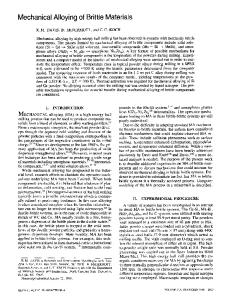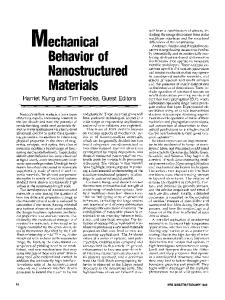Hydrogen-Diffusion Mechanical Treatment of Structural Materials
- PDF / 1,272,499 Bytes
- 8 Pages / 594 x 792 pts Page_size
- 58 Downloads / 384 Views
HYDROGEN-DIFFUSION MECHANICAL TREATMENT OF STRUCTURAL MATERIALS Ya. M. Hladkyi,1 S. S. Bys’,1,2 and V. V. Myl’ko1
UDC 621:787.785.9.902
We consider a new approach to the solution of the problems of elevation of the wear resistance of cutting tools and enhancement the serviceability of structural materials. It is based on the analysis of the physicomechanical and physicochemical influence of hydrogen in the cutting zone. The hypothesis of hydrogen-diffusion mechanical treatment and the concept of hydrogen-accumulating tool are proposed. We consider various sources of gaseous hydrogen. The process of cutting in the presence of hydrogen is studied and the obtained results are analyzed. Keywords: hydrogen-induced wear, structural materials, mechanochemical wear, chip formation, hydrogen accumulators.
Introduction The possibility of application of difficultly machined structural materials (high-strength, refractory, and heat-resistant steels and alloys) is connected with the problem of chip removal (chip crushing). This may lead to premature failures of tools and a decrease in productivity. The improvement of the methods aimed at increasing the wear resistance of cutting tools, the serviceability of structural materials, and the productivity of cutting is an actual problem for the researchers and producers. The preliminary saturation of billets or tools with electrolytic hydrogen under certain conditions facilitates the formation of chips and increases the wear resistance. However, the impossibility to control the depth of hydrogen penetration in the process of saturation, the necessity of application of especially high-power equipment for large billets, and a short “lifetime” of electrolytic hydrogen restrict the possibility of extensive application of this method. At the same time, the attempts to deliver hydrogen into the cutting zone from gas vessels and to use a special installation give good results: the temperature-and-force conditions of cutting, the durability of the tool, and the character of chip formation undergo significant changes [1]. However, this technology has numerous significant disadvantages, including the application of gas vessels with liquefied hydrogen, which is, in fact, inadmissible under the production conditions, both for the safety reasons and from the economical point of view. As a result of the analysis of available methods used for the delivery of hydrogen into the cutting zone and estimation of their positive and negative aspects, it was proposed to use, as a source of atomic hydrogen, the socalled tool-accumulator [2], i.e., a tool covered with hydrogen-containing coating capable of the accumulation of hydrogen at high temperatures and characterized by the possibility of rapid recharging. In [3], the observed intensification of mechanical treatment was theoretically justified and the results of experimental investigations were interpreted. The effect of hydrogen on the mechanical properties of metals is one of the strongest effects, as compared with the other gases [4]. The unique mob
Data Loading...











